32 Lone Star
Lone Star

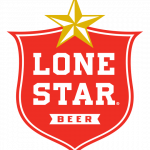
Introduction:
Known as “The National Beer of Texas” it’s been described by drink and culture websites as. “Way more than a refreshing brew with a snappy slogan”. (“Lone Star Beer Facts That Ever Beer Lover Should Know,” 2016). “Lone Star” beer has been around since 1883, having been around for many influential and devastating times in history, but these events helped craft and create the beer brand hat is enjoyed today. Lone Star beer is one of the oldest native American beers, brewed and crafted in the heart and soul of San Antonio, Texas, one historical achievement that Lone Star is proud of is that, “Lone Star’s first largest mechanized brewery was built in 1883.” (“Heritage – Lone Star Beer,” 2018). Having the “Lone Star” beer company and brand be around for over 125 years in the business. To introduce the company, you have to start where it’s first dollar was invested into the company and who crafted the idea of “Lone Star”, it was all made possible by Adolphus Busch, a well known beer baron and a group of businessmen who formulated the idea of “Lone Star” and produced their first beer in 1884. Thanks to Peter Kreil, a master brewer, he crafted the brew that we all love and enjoy today whether “served ice cold or with a burger your evening will always be a day to remember”, is how Peter hoped Texians would describe their favourite beer “Lone Star” as. (“Heritage – Lone Star Beer,” 2018). If you’re ever in Texas, it’s highly recommended that you see the San Antonio Museum which use to be the Lone Star brewery back in the 1800’s and opened it as the Museum of Art in 1981. Lone Star is not only well known for their beer but as well for, “The Lone Star Brewery has had a history of purchasing art and the museum as in 1956, the company purchased the buckhorn saloon and museum collection, and continue to add to the collection today.” (“Heritage – Lone Star Beer,” 2018).
Origins:
Having been in business for around 125 years, “Starting in 1883, beer baron Adolphus Busch and his business partners build The Lone Star brewery in San Antonio, which was the first large mechanized brewery in Texas. One year later The Lone Star brewery produces its first beer, growing more popular every beer sold.” (“Heritage – Lone Star Beer,” 2018). On the Lone Star Heritage section on their website, “In 1904; The Lone Star’s original brewing building outgrows its original wooden structure and decides to build nine buildings, that were operational until prohibition in the 1930’s.” (“Heritage – Lone Star Beer,” 2018). After years of prohibition and Americans struggling to do anything to find beer without being caught, Lone Star re-opens in 1933. The company then; “Operated under name to the Champion Brewing Company until 1940, at which time it was purchased by the Muchlebach Brewing Company of Kansas City, Missouri.” A huge part of their history however is when “The company re-branded itself as the Lone Star Brewing Company and began officially producing Lone Star Beer that year.” (“Lone Star Beer Facts That Ever Beer Lover Should Know,” 2016).
Key Milestones:
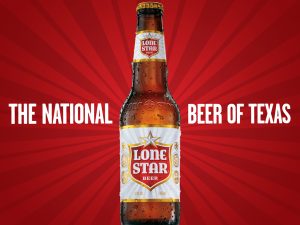
The Lone Star Brewing took off with the end of prohibition in 1933, as in 1949, the company annual sales exceeded 1 million barrels of beer sold. Lone Star always recognizes the individuals that helped make what their beer brand taste and represents today. “Thanks to master brewer Peter Kreil, in 1940 he creates the formula for the first beer to be called Lone Star Beer.” (“Heritage – Lone Star Beer,” 2018). The brewing company goes public and Lone Star’s product goes into high demand. In 1956, “The brewery decided to buy the Buckhorn Saloon and Museum in downtown San Antonio, located near the Alamo on Houston Street, this saloon is full of artifacts, including mounts of wild game hunted around the world.” (“Lone Star Beer Facts That Ever Beer Lover Should Know,” 2016). What put the company “Lone Star Beer” on the map was in 1965,” The company’s annual sales exceed 1 million barrels, helping Texas become one of the leading states in the production of beer.” (“Heritage – Lone Star Beer,” 2018). Another milestone for Lone Star is when they were remodelling their beer bottle style, called “longnecks” due to the it being easier to grip, have an inti-slippage curve and is easier for a smoother taste while drinking. This change to the bottles caught the eye of Lone Star marketers and branders who helped create and embodied what Lone Star is. Many famous actors and singers come from Texas or use Texas and their lifestyle as inspiration for their music. A huge milestone to any beer company is being advertised by anyone famous, this advertising reaches a new audience to drink their beer. “The first television episode of Austin City Limits, featured Willie Nelson”. (“Heritage – Lone Star Beer,” 2018). In this episode he is seen drinking Lone Star, from their sales skyrocketed. As well Jim Franklin, one of the lead marketing heads, produced the iconic poster that featured an armadillo. “Causing the armadillo became the official Texas state mascot in 1981.” (“Heritage – Lone Star Beer,” 2018). Lone Star Beer is a true success story; “As in 2005 they company celebrated 65 years as being the National Beer of Texas.” (“Lone Star Beer Facts That Ever Beer Lover Should Know,” 2016).
Brewing Science and Industrailization:
When discussing the brewing science and industrialization of beer, you have to go back to the huge technological developments that have drastically impacted how we transport and make beer today. The development of how beer is changed by inventions such as beer wort measures and the levels that the beer is kept at during fermentation with changes whether it will be a lager which is a lighter beer or a beer that has is a darker beer from a pilsner to a stout is brewed at a warmer temperature. As the demand for beer grew higher, mass production began, more wheat and barley were grown just for beer, bottles for beer were created and Pabst’s, a large owner of many companies including Lone Star, “produced over 800,000 barrels a year.” (Week 5, 2019). The brewing process became industrialized with motorized transportation of beer such as trains which were not refrigerated and could carry beer to further location and keep it fresher for longer.
Beer Style:
Lone Star Beer can be described in many ways, it has a light refreshing crisp taste, but Lone Star beer is mostly known for their three top selling beers called Lone Star 24/7, Lone Star Texas Light and their original and classic beer Lone Star. Lone Star Beer would be classified as a lager having a light golden appearance with a fresh crisp taste. Lager’s are one of the oldest beer styles around, being traced back to the middle ages, fermenting the beer style lager and beer in general happened accidently when a pot of yeast was left out and when it rained and the temperature changed, it fermented the yeast into a drinkable extract which was highly enjoyed by workers and those in the higher end of the work class pyramid. Lone Star beer is described by the LCBO and other distributors as “Is made with Pacific Northwest hops, malted barley and corn extract, wispy grain aromas lead to mild sweet corn and malt flavours with a light crisp finish.” (“Lone Star Beer | LCBO,” 2010). Thanks to Peter Kreil, a master brewer from when the company was first developing it’s beer flavour, he crafted the brew that Texan’s enjoy.
WWI and WWII Era:
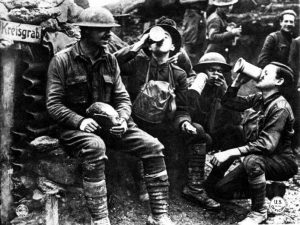
Lone Star Beer became very popular after their first beer in 1884, as stated on their website, “In 1904; The Lone Star’s original brewing building outgrows its original wooden structure and decides to build nine buildings, that were operational until prohibition in the 1920’s.” (“Heritage – Lone Star Beer,” 2018). In between those years however, World War I had happened making a lot of changes to American’s lifestyle impacting beer especially. Shortages of wheat, barley and hops for beer had been cut drastically as these resources were needed for soldiers to fuel them for battle, however though it was still produced, just in smaller quantities. Then Prohibition happened in the 1920’s, banning all service, brewing and consumption of liquor. This drastic change in America, was to reduce crime and drunkenness but it may have increased it due to American’s doing anything even illegal acts to get their beer, causing gangs and illegal trading and smuggling of booze. Then once Prohibition ended, restrictions were put in place against the hours that you could drink beer and where you could drink it. Following that WWII had been declared with Canada, America and Britain and other European allies against Germany. Starting in 1939, there were rations on ingredients needed for beer, this made beer a lot lighter and less alcoholic beer. It was however still drank by American soldiers that were across the sea’s, drinking their homeland beer as well as German beer which was an ale, a lot more popular than lagers in Europe at the time. Once the war ended in 1945, “Americans came back home and starting drinking beers not just at pubs but in there homes as well.” (“WW2 BEER FINAL,” 2019).
Consolidation and Globalization:
Today, Lone Star beer can be found mostly in the United States and Canada, as it isn’t quite popular yet in European countries as it’s a standard beer and is marketed towards it’s American drinkers mostly. But beer however from all over the world, have been shipped due to glob
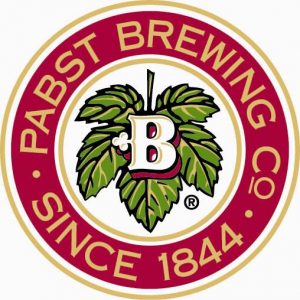
alization and the demand of certain beer products to be sold in their country. The globalization of beer has such a huge magnitude on the industry business and what we have learned from globalization so far. “The brew industry Is unity of the oldest industries recovered in the world.” (claims, 2019). As beer consumption and some countries grew economically so did globalization of beer. As stated from a website about food security and agriculture, “In recent times, per capita consumption has decreased in traditional beer drinking countries while it increased strongly in emerging economies. Recently, China has overtaken the US as the largest beer economy.” (“Economic Growth, Globalisation and Beer Consumption,” 2015). This is a huge change because when you think of beer and who drinks and advertises it the most it’s the States, however globalization can be defined as businesses or organizations starting or influence operations on an international scare. Meaning that all a country needs for globalization is to be a wealthy country and can invest. To put into simpler terms, “The relationship between income and beer consumption has an inverse U-shape. Beer consumption initially increases with rising incomes; but at higher levels of income beer consumption falls. Increased globalization has contributed to a convergence in alcohol consumption patterns across countries. In countries that were originally beer drinking countries, the share of beer in total alcohol consumption reduced, while this is not the case in countries which traditionally drank mostly wine or spirits.” (“Economic Growth, Globalisation and Beer Consumption,” 2015).
Marketing and Branding:
Lone Star was purchased by Pabst Brewing Company in 1999, they own many treasured American brands, owning over 50 brands Lone Star is one of the many other beer brands they own. On their website its important that they recognize that owning these brands has certain responsibility. “We respect our past while always looking towards the future, creating enduring American brands and stories that connect all generations. Our brands are focused on making a contribution to culture, fostering authentic community connections, and offering people great drinks for all occasions.” (“Brands – Pabst,” 2019). Although Lone Star isn’t owned by its original owners anymore, its important that they market their brand to represent where they came from and the years of quality beer behind its name. Since many country artists drink beer, they often featured Lone Star in their music videos or in their songs such as, “In the 1970s, Lone Star’s sales benefited from Jerry Retzloff, former marketing and promotions manager for Lone Star Beer and his close association with Willie Nelson, the Austin music scene and their Giant Armadillo.” (“Heritage – Lone Star Beer,” 2018). Then 20 years later again, “The beer is mentioned frequently in the title track of Red Steagall’s 1976 album “Lone Star Beer and Bob Wills Music”. In 1999, the company began to sponsor Texas singers and musicians, such as Two Tons of Steel, with the beer’s “It’s a Texas Thing” advertising campaign.” (“Heritage – Lone Star Beer,” 2018). From this brand and what they advertise, customers expect a refreshing drink to enjoy with friends that embodies the Texan lifestyle and traditions. It logo is a shield, often with the writing of “The National Beer of Texas” beside it, always coming back to their history.
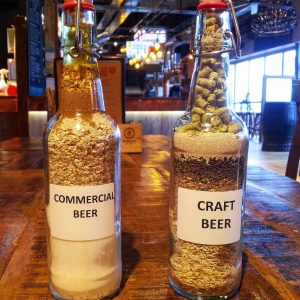
Modern Era:
Lone Star beer has been around since 1883, this brand experiencing three different centuries of consumers and to create beer and the different trends and needs of it’s customers. Simple changes such as it’s logo and to its packaging has developed, “Starting with the logo where they simplified it such as making it’s iconic red logo more vibrant making it stand out more and enlarging the size of badge logo.” (Camphq, n.d.). The modernization era of beer comes down to how beer is marketed and created whether to fit the craft beer idea or commercial beers. With craft beer becoming competition for many commercial beer brands such as Lone Star beer, it’s a fight for which beer brand stands out the most and taste the best. As beer lovers are moving towards craft beers due to do their unique, new taste and the idea that each beer is made in small quantities and it supports small business tops the idea of a mass-produced commercial beer which doesn’t benefit the community or its consumers in return. Lone Star beer brews and continues to beer in Texas, continuing to be know for its most enjoyed beer formula. “Which was not until 1940 that brewer Peter Kreil from Munich created the formula for the first beer to actually be called Lone Star beer.” (Heritage. n.d.). The beer is brewed by now, owner of the company “Pabst Brewing Company”, which was purchased in 1999, and as beer changes and the modernization of craft beer moves in it’s important that Pabst understands the uniqueness

and traditions of Lone Star beer. Pabst stating: “We respect our past while always looking towards the future, creating enduring American brands and stories that connect all generations.” (“Brands – Pabst,” 2019). As the beginning of the craft movement began in 1965, Lone Star beer has seen no impact of this, in fact with the rebrand of Lone Star beer they noticed that, “Lone Star drinkers, servers, sellers, and distributors embraced the rebrand. Texans began requesting the “new can” or “new bottle” when ordering beer at bars. Sales of bottles/cans/packs increased 23% YOY.” (Camphq, n.d.). In conclusion, Lone Star beer is most thankful for it’s dedicated customers and to have been in business for this long, facing different challenges and learning to make their brand appealing to consumers during the modern era and the popularization and rise of craft beer in America as well as other parts of the world.
Multi-Media:
- “National Beer of Texas.” https://i.pinimg.com/originals/b5/27/a3/b527a3c83635d974609c9be453d27992.jpg
- “Lone Star Logo.” Https://Sponsorpitch.com/System/Sponsors/Images/000/008/732/Original/Lonestar-540.Png.
- Texas . https://i.pinimg.com/originals/e9/26/ff/e926ff24a80eac641ecae33b98653a87.jpg .
- Pabst Brewing Company. (n.d.). photograph. Retrieved from https://unofficialnetworks.com/2012/03/22/unofficial-beer-pabst-brewing-hires-anheuserbusch-exec-cmo/
- Soilders Drinking Beer. (n.d.). photograph. Retrieved from http://www.nuttyhistory.com/uploads/1/2/1/5/12150034/1100048_orig.jpg
- Lone Star beer through the ages. (n.d.). photograph. Retrieved from https://www.statesman.com/storyimage/TX/20181115/NEWS/181119080/AR/0/AR-181119080.jpg
- Craft vs Commercial. (n.d.). photograph. Retrieved from https://pbs.twimg.com/media/C69WfQBWoAAyYgB.jpg
- Vintage Lone Star Beer Can . (n.d.). photograph. Retrieved from https://i.pinimg.com/originals/bf/df/be/bfdfbe8a776d5b20f8be7ae4a84292a2.jpg
References:
- Heritage. (n.d.). Retrieved from https://lonestarbeer.com/heritage/. Hoyt, A. (2008, January 8). How Prohibition Worked. Retrieved from https://history.howstuffworks.com/historical-events/prohibition4.htm.
- Office of Historic Preservation. (n.d.). Retrieved from https://www.sanantonio.gov/historic/scoutsa/HistoricDistricts/LoneStar.
- Vrba, S. (2017, November 17). Lone Star Beer Facts That Ever Beer Lover Should Know. Retrieved from https://www.wideopencountry.com/10-things-didnt-know-lone-star-beer/
- Cajundelyon, E. (2013, April 24). Retrieved September 30, 2019, from https://www.youtube.com/watch?time_continue=101&v=l6DkxPlfZho.
- Lone Star Beer | LCBO. (2010). Retrieved November 8, 2019, from https://www.lcbo.com/webapp/wcs/stores/servlet/en/lcbo/north-american-lager-16023071050/lone-star-beer-10218#.XcX6UW5FzRM
- Week 5. (2019). Week 5. Retrieved November 9, 2019, from Google https://docs.google.com/presentation/d/1lDiQKqMbpfvIifCI1kR3IXo_e_yaEqnCRWG3teckExs/edit#slide=id.g63bd7568ec_0_119
- WW2 BEER FINAL [YouTube Video]. (2019). Retrieved from https://www.youtube.com/watch?time_continue=311&v=-h3EDnspynQ&feature=emb_title
claims. (2019, November 10). The Globalization of Beer. Retrieved November 10, 2019, from Blogspot.com website: https://claims-blog.blogspot.com/2011/02/globalization-of-beer.html - Economic Growth, Globalisation and Beer Consumption. (2015, November 29). Retrieved November 10, 2019, from European Commission website: https://ec.europa.eu/jrc/en/publication/economic-growth-globalisation-and-beer-consumption
- Brands – Pabst. (2019). Retrieved November 10, 2019, from Pabst.com website: https://pabst.com/brands/
- Camphq. (n.d.). Lone Star Beer. Retrieved from https://camphq.com/lone-star-beer/.

